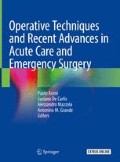Abstract
Thoracic trauma is the second leading cause of death in case of trauma, after head trauma. Rib fractures are one of the most common injuries affecting trauma patients, occurring in approximately 10% of all cases, and they are associated with a mortality of 3–13%. Frequent complications of this condition are pneumonia, prolonged ventilator time, prolonged hospitalization, and chronic debilitating pain. It has been shown that a greater number of rib fractures are associated with an increased risk of complications, particularly in older patients. Optimal treatment of rib fractures has not been established; in particular, the role of surgery is a matter of debate.
Diaphragmatic injuries have been reported in 0.8–20% of patients hospitalized for blunt trauma and in 3.4–47% of patients sustaining a penetrating thoracoabdominal trauma. Mechanism of injury may be dissipation of energy from the abdominopelvic cavity to the chest in case of blunt trauma or penetrating thoracoabdominal trauma. These result in a laceration of the diaphragm, causing a hernia, that can be diagnosed in the acute setting or remain silent for months or years.
Access this chapter
Tax calculation will be finalised at checkout
Purchases are for personal use only
References
Pieracci FM, Majercik S, Ali-Osman F, Ang D, Doben A, Edwards JG, French B, Gasparri M, Marasco S, Minshall C, Sarani B, Tisol W, VanBoerum DH, White TW. Consensus statement: surgical stabilization of rib fractures rib fracture colloquium clinical practice guidelines. Injury. 2017;48(2):307–21.
Galvagno SM Jr, Smith CE, Varon AJ, Hasenboehler EA, Sultan S, Shaefer G, To KB, Fox AD, Alley DE, Ditillo M, Joseph BA, Robinson BR, Haut ER. Pain management for blunt thoracic trauma: a joint practice management guideline from the Eastern Association for the Surgery of Trauma and Trauma Anesthesiology Society. J Trauma Acute Care Surg. 2016;81(5):936–51.
Senekjian L, Nirula R. Rib fracture fixation: indications and outcomes. Crit Care Clin. 2017;33(1):153–65.
Olland A, Renaud S, Reeb J, Guinard S, Jeitlinger J, Santelmo N, Falcoz PE, Massard G. Traitement chirurgical des traumatismes fermes du thorax et technique de l’osteosynthese costale. Encyclopedie Medico Chirurgicale, Techniques chirurgicales Thorax. 10.1016/S1241-8226(16)64626-1.
Kucharczuk JC, Cohen JE. Thoracic Trauma, Chapter 100. In Intensive Care Unit Manual, pp. 916–20.
Bailitz J, Hedayati T. Thoracic trauma. Emerg Med. 78:681–94.
Asensio JA, Trunkey DD. Thoracic injuries. In: Asensio JA, Trunkey DD, editors. Current therapy of trauma and surgical critical care. 2nd ed. New York: Elsevier; 2016. p. 205–28.
Bhavnagri SJ, Mohammed TL. When and how to image a suspected broken rib. Cleve Clin J Med. 2009;76(5):309–14.
Davis S, Affatato A. Blunt chest trauma: utility of radiological evaluation and effect on treatment patterns. Am J Emerg Med. 2006;24(4):482–6.
Peters S, Nicolas V, Heyer CM. Multidetector computed tomography-spectrum of blunt chest wall and lung injuries in polytraumatized patients. Clin Radiol. 2010;65(4):333–8. Epub 2010 Feb 12.
Griffith JF, Rainer TH, Ching AS, Law KL, Cocks RA, Metreweli C. Sonography compared with radiography in revealing acute rib fracture. Am J Roentgenol. 1999;173(6):1603–9.
Zaw AA, Murry J, Hoang D, Chen K, Louy C, Bloom MB, Melo N, Alban RF, Margulies DR, Ley EJ. Epidural analgesia after rib fractures. Am J Surg. 2015;81(10):950–4.
Mohta M, Verma P, Saxena AK, Sethi AK, Tyagi A, Girotra G. Prospective, randomized comparison of continuous thoracic epidural and thoracic paravertebral infusion in patients with unilateral multiple fractured ribs—a pilot study. J Trauma. 2009;66(4):1096–101.
Simon BJ, Cushman J, Barraco R, Lane V, Luchette FA, Miglietta M, Roccaforte DJ, Spector R. Pain management guidelines for blunt thoracic trauma; EAST Practice Management Guidelines Work Group. J Trauma. 2005;59(5):1256–67.
Kerwin AJ, Haut ER, Burns JB, Como JJ, Haider A, Stassen N, Dahm P, Eastern Association for the Surgery of Trauma Practice Management Guidelines Ad Hoc Committee. The Eastern Association of the Surgery of Trauma approach to practice management guideline development using Grading of Recommendations, Assessment, Development, and Evaluation (GRADE) methodology. J Trauma Acute Care Surg. 2012;73(5 Suppl 4):S283–7.
Tanaka H, Yukioka T, Yamaguti Y, Shimizu S, Goto H, Matsuda H, et al. Surgical stabilization of internal pneumatic stabilization? A prospective randomized study of management of severe flail chest patients. J Trauma. 2002;52:727–32; discussion 732.
Granetzny A, Abd El-Aal M, Emam E, Shalaby A, Boseila A. Surgical versus conservative treatment of flail chest. Evaluation of the pulmonary status. Interact Cardiovasc Thorac Surg. 2005;4:583–7.
Marasco SF, Davies AR, Cooper J, Varma D, Bennett V, Nevill R, et al. Prospective randomized controlled trial of operative rib fixation in traumatic flail chest. J Am Coll Surg. 2013;216:924–32.
Voggenreiter G, Neudeck F, Aufmkolk M, Obertacke U, Schmit-Neuerburg KP. Operative chest wall stabilization in flail chest-outcomes of patients with or without pulmonary contusion. J Am Coll Surg. 1998;187:130–8.
Blitz M, Louie BE. Chronic traumatic diaphragmatic hernia. Thoracic Surg Clin. 2009;19(4):491–500.
Steyn E. Penetrating injuries to the diaphragm. In: Velmahos GC, Degiannis E, Doll D, editors. Penetrating trauma. Berlin: Springer; 2017.
Hanna WC, Ferri LE. Acute traumatic diaphragmatic injury. Thorac Surg Clin. 2009;19(4):485–9.
Dante Yeh D, Lee J. Trauma and blast injuries. In: Robert Mason V, Broaddus C, Martin T, et al., editors. Murray and Nadel’s Textbook of respiratory medicine. 5th ed. Philadelphia: Saunders. p. 1354–66.
Dalshaug GB, Rothwell BC. Diaphragmatic paralysis following minor blunt trauma. J Trauma. 1999;47(2):413–5.
Ko MA, Darling GE. Acquired paralysis of the diaphragm. Thorac Surg Clin. 2009;19(4):501–10.
Groth AS, Andrade RS. Thoracic surgery clinics. Diaphragmatic Eventration. 2009;19(4):511–9.
Author information
Authors and Affiliations
Editor information
Editors and Affiliations
Rights and permissions
Copyright information
© 2019 Springer International Publishing AG, part of Springer Nature
About this chapter
Cite this chapter
Antonacci, F., Renaud, S., Mazzucco, A., Orlandoni, G., Santelmo, N. (2019). Chest Wall and Diaphragmatic Injuries. In: Aseni, P., De Carlis, L., Mazzola, A., Grande, A.M. (eds) Operative Techniques and Recent Advances in Acute Care and Emergency Surgery. Springer, Cham. https://doi.org/10.1007/978-3-319-95114-0_19
Download citation
DOI: https://doi.org/10.1007/978-3-319-95114-0_19
Publisher Name: Springer, Cham
Print ISBN: 978-3-319-95113-3
Online ISBN: 978-3-319-95114-0
eBook Packages: MedicineMedicine (R0)

